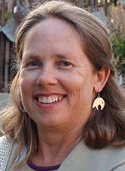EagleCAM captures island nest with two healthy chicks. And, yes, Noozhawk’s Karen Telleen-Lawton is hooked on the voyeuristic view.
Behind my Dell screen a vocal bird band accompanies my writing. I hear a Pacific slope flycatcher and perhaps chats, warblers and island scrub jays. Below these confident calls I discern tiny peeps, barely audible. Then I hear some fluttering: a combination wing whrrr and snap of twigs. Quickly I click on the EagleCAM tab on the bottom of my screen to find K-10 arriving to relieve his partner, K-26. EagleCAM is a live Web camera located beside a bald eagle nest near Pelican Harbor on Santa Cruz Island. I’ve inserted myself into their burgeoning family.

K-26 looks frenzied, her tail feather sticking out here, maybe a furrowed brow. OK, I’m anthropomorphizing now, but I can’t help empathizing with these parents. After weeks of boredom and perhaps hunger, sharing egg-sitting duties on a massive structure of pine and manzanita sticks gently swaying atop a Bishop pine, life has become frantic. Now a pair of chicks wriggle in the grass- and soil-lined nest and vie urgently for food.
The cheeps grow incessant with the arrival of the meal-laden parent. K-10 stretches his neck in an elegant Pilates move and regurgitates some food for the screaming chicks. The chicks’ down is blindingly white; smaller than the snowy heads of their bald eagle parents.
Passing the food — precarious, laborious and frustrating — is increasingly better-coordinated hour by hour and day by day. The process is mesmerizing.
One chick, presumably the day-older one, is definitely more active and demanding than the other. K-10 and K-26 bend and stretch, pulling up food from their gullet and craning to reach the beaks of the tiny chicks deep in the center of the nest. Are they trying to share even-steven? Are they torn between upchucking that good gull or fish morsel and swallowing it for their own nourishment? Are they exasperated at the task?
Seven-year-old K-10 and 6-year-old K-26 first used this nest in 2006, hatching the first chick (A-49) in more than 50 years on the Channel Islands. They are two of the pioneers for the Institute for Wildlife Studies funded by the Montrose Settlements Restoration Program.
The program’s purpose is sustainability: to restore natural resources harmed by DDTs and PCBs released into the environment by Montrose Chemical Corp. and other industrial sources in the mid-20th century. The Ventura County Education Office, National Park Service, The Nature Conservancy and San Francisco Zoo are also program participants.
The feasibility study’s aim was to determine if bald eagles could be successfully restored on the northern Channel Islands. Eaglets, including K-10 and K-26 hatched at the San Francisco Zoo and collected from nests in Alaska, were placed in hatching towers when they were about 8 weeks old. Since 2002, 61 bald eagles — now 63! — have hatched on the northern Channel Islands. More than two dozen have chosen to call them home.
That’s the bald statistics, but it’s my screen that shows the successful reality. I’m in their nest, and sometimes I feel like I’m almost in their heads. When the wind blows, whipping the branch and scudding the speakers, I feel anxious and lonely. What are they thinking?
The live feed is less than 30 miles from me, but the bird family’s audience is worldwide. EagleCAM lists 844 topics yielding comments from more than 100,000 viewers, mostly in the last couple of weeks. Why? Maybe because it’s better than Supernanny; a chance to see good parenting lessons like patience, sharing the load, getting rest, and avoiding outside distractions. Or maybe it’s even deeper: the chance to witness sustainability in action.
Click here for the Santa Cruz Island Web cam.
Karen Telleen-Lawton’s Serendipity column is a mélange of observations supporting sustainability. Click here to graze her writing and excerpts from Canyon Voices: The Nature of Rattlesnake Canyon.

Karen Telleen-Lawton, Noozhawk Columnist
This article was published on April 14th, 2020 in Noozhawk – you can read it “in print” here.
Karen Telleen-Lawton is an eco-writer, sharing information and insights about economics and ecology, finances and the environment. Having recently retired from financial planning and advising, she spends more time exploring the outdoors — and reading and writing about it. The opinions expressed are her own.
KTL at CanyonVoices dot com

